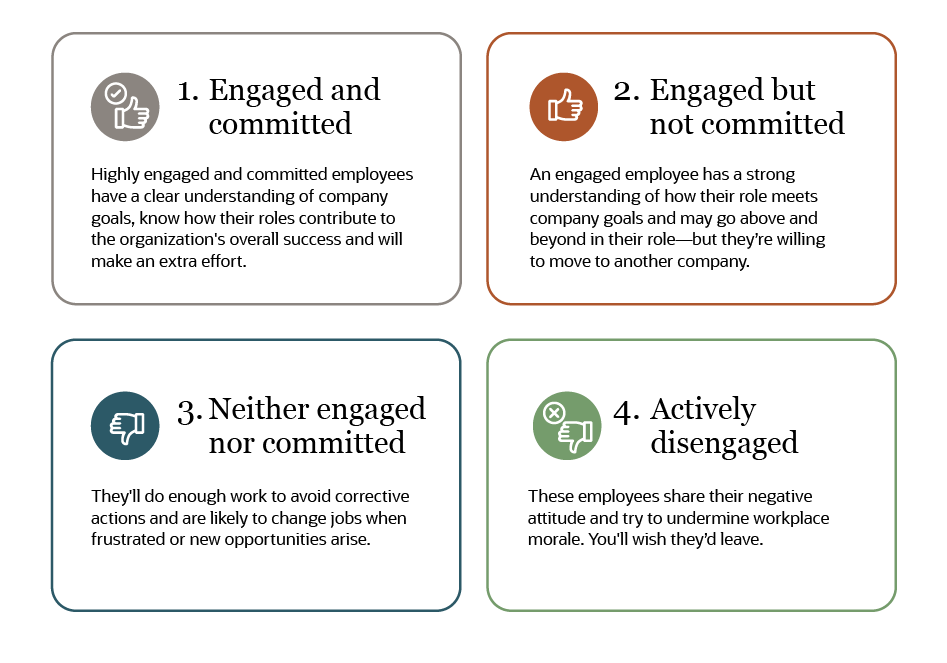It’s more than just having happy or motivated employees. Engaged workers are invested in the success of the business and actively work to meet strategic goals. It takes time, planning and effort, but improving employee engagement can return dividends and is a key component of productivity, profitability and employee retention.
What Is Employee Engagement?
Employee engagement looks beyond if your employees are just happy. Some people will be happy to give the minimum at work and collect a paycheck. Instead, employee engagement is a way to approach and measure how fulfilled and connected your employees are to your business and its success. It’s about finding ways to create the right conditions and providing the right support so employees are committed to your company’s growth. Engagement is the behavior that results from conditions that make an employee feel fulfilled, valued, satisfied and invested in the organization’s prosperity.
What Employee Engagement is Not
Employee engagement is not just about a feeling. It’s not just a sense of happiness or satisfaction, or even liking a specific company. An employee can like a job because she gets paid well, but it doesn’t necessarily mean she’s actively engaged in her work and dedicated to helping her company grow.
Video: What Is Employee Engagement?
Employee Engagement vs. Employee Satisfaction
Employee satisfaction doesn’t address someone’s level of commitment, motivation or involvement in an organization. Instead, it only indicates how content your employees are. For example, some employees might be satisfied doing the bare minimum to not get fired while collecting their paychecks and enjoying time off and other benefits.
| Employee Engagement | Employee Satisfaction |
|---|---|
| How passionate employees are about their roles’ value and how committed they are to the company — this is related to how much extra effort they may perform. | How content employees are with their jobs and work environment. |
| Engaged employees are deeply involved in the work they perform. | Employees can be satisfied with their job while not being engaged. |
| Engagement results in retention, additional productivity, work quality and customer satisfaction. | Satisfaction is enough to retain employees, but not necessarily enough to increase productivity. |
Changes in employee satisfaction may not lead to better employee performance, but employees who are engaged are seeking out new challenges and ways to improve themselves, as well as the company.
Employee Engagement Explained
Think about a time you were engaged in a job or activity. It could be learning a new hobby or really hitting your stride at work. Regardless, there were likely a few conditions. You probably felt challenged, but knew you had the resources to overcome obstacles that might come up. You were probably proud of the work when it was finished and were excited to do it again because you’d learned from your experiences — perhaps you saw a correlation between your work and the success or growth of your company. Helping employees find that level of engagement is mutually beneficial. As they become more satisfied and advance their careers, they help your business improve and become valuable assets.
Cultivating high employee engagement levels and commitment comes through gaining their trust with integrity, transparency and mutual trust. Communication is key, and one of the most common ways to drive employee engagement is through managers who embrace these values and work with employees to improve the conditions that can contribute to employee engagement. And since there are ways to measure engagement, you can nurture and improve it.
Why Is Employee Engagement Important?
Companies with an engaged workforce are more successful. Productivity increases. Employees are satisfied and absorbed in their work so they’re more likely to stick around. Engaged employees will leverage their networks and refer top talent into the organization. Customer loyalty increases because of the reciprocal quality and service that comes from engaged employees. And engaged employees are more likely to look at the bigger picture because they understand their place and purpose in the business and how what they do can affect the outcome of the company. All of this impacts the financial health of your business.
History of Employee Engagement
The term employee engagement emerged in the 1990s in The Academy of Management Journal(opens in new tab) as a concept in response to the shift in the attitudes of the workforce. Increased global competition led to decreased job security and a more fluid workforce as a result. As employee turnover increased, it impacted employers’ ability to stay competitive, and replacement and lost job skills were costly to the business.
Human resource departments were focused on the day-to-day operations of things like hiring, benefits administration and working through personnel issues. There wasn’t a strong connection between HR and the financial health of the company. But as businesses began to see costs rise as a result of more frequent turnover and the benefits of things like customer retention through engaged and enthused employees, employee engagement became a benchmark that included an approach to improving company culture, as well as trainings for managers and companywide programs.
And now, technology like human capital management (HCM) software is making employee engagement programs and efforts more efficient than ever. It helps with every step of the way, from filling positions with qualified candidates to tracking employee progress toward goals and other engagement tools.
Engaged vs. Disengaged Employees
Employees who are more engaged feel a real connection to their jobs and understand how their role contributes to the organization's overall success. They’re challenged, mentored and encouraged to excel. Disengaged employees are on the other end of the spectrum and often do the minimum amount of work required. Disengaged employees are more likely to isolate from their co-workers, complain frequently and don’t make the connections with colleagues that help create a positive work environment. Instead, their behavior can be a drag on team morale.
Key Differences
| Engaged employees | Disengaged employees |
|---|---|
| Are optimistic and hopeful for the future. They still face challenges but feel supported as they address and overcome them. | Feel undervalued and unsupported by management. New challenges overwhelm, and they feel discouraged about the future. |
| They are team players. They understand their role in the company and how it fits into broader business goals. Expectations for how they can succeed and advance are clear. | Job expectations are unclear. They don’t see how their role impacts business goals and don’t know how it relates to the work of their team, often making being a good teammate difficult. |
| These employees are invested in the future of the business. They understand how helping the business grow also helps their career advance and job satisfaction improve. They go the extra mile. | These employees can’t see a big picture plan. They’re collecting their paychecks but aren’t actively working toward clear and inspiring goals. They’re often late to work, constantly watching the clock or bringing down team morale. |
| They see challenges as opportunities. In part because they know that they have the mentorship and support from the company to overcome them. They aren’t afraid to share new ideas and offer solutions because they’ve been supported by their managers and know their ideas are valued. | They’re looking for a prescriptive approach to solving problems. They don’t offer solutions because their ideas have been shot down or ignored in the past. Their managers don’t offer support and they feel they have to address problems by themselves, leaving them overwhelmed and unmotivated. |
| These employees are excited about new training and learning opportunities. They see how it benefits their own professional growth, as well as the company’s bottom line. And they see a bigger picture where career advancement is an exciting and mutually beneficial relationship with their employer. | These employees are interested in doing the bare minimum and collecting a paycheck. Perhaps because managers have not encouraged or supported new learning opportunities or because there’s been no career path or growth potential in the past. |
| Because they see how they fit into the overall business strategy, these employees celebrate wins by colleagues and give and share credit for accomplishments. They don’t feel threatened by the career growth of others, because they see and understand their own. | Unhealthy competition and infighting are common among these employees. Rather than feeling like a team working toward the same goals, these employees feel they have to protect themselves from the success of others and will sometimes accept or claim credit for the work of others. |
| These employees understand that mistakes happen and know their managers and peers also know that. When an accident or mistake does occur, they apologize for the error and start making plans to make sure it doesn’t happen again. They see mistakes as a learning opportunity. | These employees are afraid of unfair consequences after making a mistake. Rather than fess up, they try to cover up. They know their managers are unforgiving and have unrealistic expectations and do not encourage learning from mistakes. |
4 Types of Employee Engagement
Changes in employee demographics and technology have a large impact in terms of what workers expect. Understanding engagement levels is key to understanding employee needs so that companies can build a foundation that enhances the reciprocal relationship between leaders and employees.
While there are many ways to look at engagement levels, here's what they generally look like.

The Roles of HR and Management in Employee Engagement
Many factors influence employee engagement, including organizational communication, workplace culture and managerial styles. Both managers and HR professionals play an important part in ensuring a company's employee engagement initiatives are well-thought-out and executed.
The Role of HR
HR professionals should have a role in fostering a culture of engagement. This includes designing, measuring and evaluating policies and practices that proactively attract and retain talented employees who have skills to ensure growth and sustainability within the organization.
The Role of Managers
Less than a third of employees are engaged at work. And half of U.S. adults(opens in new tab) have left a job just to get away from a poor manager. The role managers play in helping employees stay engaged is massive. But it’s not just that some managers are good, and some are bad. There are common behaviors among managers who help their reports become and stay engaged in their work.
Communication
Employees need to understand what’s expected of
them. And
that goes beyond just a list of job duties. Successful managers consistently communicate.
They meet regularly and communicate via phone, email and in person when applicable. And the
communication isn’t just one-way. Successful management responds to employee emails
and
concerns.
Try to make genuine connections with your employees. Get to know them personally and make them feel comfortable talking about personal as well as professional concerns. In a productive workplace, your employees will feel safe to share ideas, challenge the way things are done and trust that their managers will support and listen to them.
Establish clear goals
This goes well beyond the annual review.
Don’t
just tell your employees their job duties and walk away. Talk with them frequently about
performance, priorities and progress. Set smaller goals that tie to annual or strategic
business goals as a way to show them how their roles impact overall business decisions.
Focus on strengths
A fish may never learn to climb a tree. And a cat may
be a terrible swimmer. Trying to train the fish to climb a tree or get a cat to like water
is a waste of time. And focusing solely or even primarily on weaknesses of employees is a
likewise fruitless effort. Gallup researchers have found that 67 percent of employees whose
managers focused on developing and celebrating their strengths were engaged. Encourage
employees to use their talents while adding training to develop skills that apply to those
strengths.
Human resources management systems (HRMS) can help managers and HR work together to empower and engage employees. HRMS is a suite of software applications that are used to engage with employees, management and HR throughout the employee lifecycle. One employee engagement benefit is it puts important and easy-to-access tools and information into the hands of employees, like trainings and feedback mechanisms. And all the reporting and analytics are stored in one centralized location for management and HR to access, monitor, measure and work toward business goals.
What Drives Employee Engagement?
Both organizational and managerial drivers highly influence employee engagement levels.
Organizational drivers
Feeling connected to the overall business, its strategy, values and goals is an important step in employee engagement. Here are five indicators that your company is taking steps to improve employee engagement.
- Employees have an understanding of how they fit into your company’s overall business strategy and goals.
- Employees believe the organization will be successful.
- Employees have the right tools and resources to fulfill their roles.
- Employees feel valued and that they’re an important part of the organization.
- Employees believe that leaders are also committed to creating a positive company culture.
Managerial drivers
Drilling down, there are important steps that managers can take to improve employee engagement and manage a high performing workforce. Here are four indicators your management is taking employee engagement seriously.
- Managers encourage and provide learning and professional growth opportunities.
- Managers communicate regularly with their employees and develop positive relationships.
- Managers provide the materials, training and support necessary for employees to do their jobs.
- Managers provide direction and support, but don’t micromanage. They establish the goals and let their employees have the freedom to make decisions on how to accomplish those goals.
What Are the Types of Employee Engagement?
The three main aspects of employee engagement involve both physical and psychological commitment.
- Emotional engagement: Engaged employees feel more attached and involved in their jobs.
- Cognitive engagement: This type of engagement refers to the extent to which employees focus on their tasks. The more engaged they are, the less likely they are to be distracted by small interruptions.
- Physical engagement: More physically engaged employees means less absenteeism and more involvement in voluntary work activities.
Employee Engagement Metrics
Before you start implementing employee engagement strategies, think of some goals you want to address. For example, is your retention poor? Or maybe you think productivity could be boosted? Having a specific goal in mind can help you identify which actions you can take. Communicate clearly with employees what problems you’re trying to address and how you plan to address them. Solicit feedback.
How is Employee Engagement Measured?
Surveys
Most of the engagement metrics are based off employee surveys. There are few ways to go about them. If you choose to administer your own surveys, HCM software can help you create, distribute and analyze the results.
- Hire a third-party firm. They can analyze the data and benchmark against peer companies, as well as provide possible courses of action to address issues that come up. These surveys are normally administered once a year or once every other year.
- Send one-click or pulse surveys. Every day send a short one- or two-question survey to employees. Ask about things like their working conditions, supervisors, goals and if they see a future for themselves at the company. HCM solutions can make this simple and store previous data so you can track progress.
- Administer your own annual survey. Focus on satisfaction, how aligned employees feel with the business goals and if they see a future at the company. Don’t forget to ask open-ended questions, as well as questions on a 1-5 or 1-10 scale. HCM platforms can help you distribute and analyze the data, as well as offer up survey questions and let you customize for different teams or areas of the business.
Productivity and Retention
Providing the tools and resources for employees to succeed isn’t just to benefit the employees. Customer satisfaction should increase and revenue should too. HR consulting service Aon Hewitt found that a 5% increase(opens in new tab) in employee engagement resulted in a 3% increase in revenue. How you measure productivity will vary by industry, but some of the common metrics include attendance rate, average hours worked and conversion rate or average sale size.
Additionally, as employees are more engaged, they’re less likely to seek other employment. Hiring and training new employees can be costly. This is a long-term goal that can save the company money and improve relationships with clients.
When in the Employee Life Cycle Should you Measure Engagement?
You should administer employee engagement programs, initiatives and efforts across the entire life cycle of your employee. In fact, onboarding is one of the most important times to begin the employee engagement journey. Employees who go through strong onboarding processes tend to be more engaged. HCM software can help you create effective onboarding processes, as well as measure employee engagement.
Employee Engagement Models
There are different models and approaches to employee engagement that leaders can adapt to their workplace.
Traditional vs modern
Traditionally, measuring engagement happened once a year in the annual review. Managers reviewed performance with employees and discussed raises. But it’s difficult for employees to feel engaged toward goals and strategies when they happen only once a year. As companies are realizing the impact engaged employees can have on the financial health of their business, they’re implementing new models and tactics to achieve engagement goals. And with powerful HCM software, companies have the tools to put in place and monitor progress of engagement programs. The best HCM solutions are adaptive and continuously updating to address new needs and innovations. Here are a few common models that have proven successful for some companies.
- Institute of Employment Studies (IES) model: This model, developed in 2003, looks at 10 core concepts to encourage employees to feel involved and valued. These include cooperation and communication, performance and appraisal, development and career and fair treatment and pay.
- Schmidt model: This model prioritizes the recruitment and retention of the right types of talent. The theory is that after hiring the workers with the right attitude and personality, an organization can focus on creating a positive work culture that leads to employee engagement.
- Penna’s model: This hierarchical model looks at basic working conditions, then moves towards promotion opportunities and trust. The very top of the pyramid looks at meaning. The idea is that the more you move up the pyramid, the more engaged your employees will be.
- The Zinger model: The David Zinger model focuses on organizational, leadership and individual outputs. It emphasizes that employee engagement will increase as these three inputs continue to be developed.
8 Benefits of Employee Engagement
Increasing levels of employee engagement help sustain and grow an organization. Here are some ways your company can benefit.
- Productivity: Engaged employees are more focused. They work better with colleagues to develop and complete projects. They’re attentive to current and future business goals.
- Retention: Engaged employees are loyal employees. They're more likely to stay on because they feel supported and valued and see opportunities for growth.
- Profitability: Increased productivity leads to lower costs and increased revenue.
- Employee satisfaction: Employees who are satisfied with their job — who enjoy working with their manager, appreciate the pay and benefits and have the support they need to meet goals — are more likely to be engaged. Companies can adapt to changing needs and desires of their workers to make their businesses a top workplace.
- Customer service and satisfaction: Happy employees can translate into more satisfied customers because of the increased quality of customer service. Employees are also more likely to come up with practical solutions to attract and retain customers.
- Shareholder returns: The more productive and profitable the business is, the more likely shareholders will see higher returns.
- Sales: Increased productivity and customer satisfaction lead to more sales, impacting a company’s bottom line.
- Lower recruiting costs: Engaged employees are more likely to refer top talent to the organization throughout their lifecycle.
Components of Employee Engagement
Engagement with management and the organization as a whole are the two main factors that drive employee engagement. Engagement with an organization looks at how confident employees are in terms of fairness, values, respect and trust. Meanwhile, managerial engagement looks at how employees view their direct managers. This can include receiving constructive feedback, exhibiting mutual respect and being treated fairly. Modern HCM software solutions(opens in new tab) help employees connect to their work by creating goals with real-time feedback. It brings together the day-to-day tasks such as goal monitoring, recognition and performance related conversation with managers to help them grow and develop their careers.
| Type of engagement | Components |
|---|---|
| Engagement in the business |
|
| Engagement with manager |
|
| Engagement within an individual’s team |
|
| Engagement with leadership |
|
| Retention |
|
| Productivity |
|
| Communication |
|
| Participation |
|
7 Ways to Improve Your Employee Engagement
Leaders need to think carefully and strategically when creating employee engagement initiatives. Here are seven ways to improve your existing efforts.
- Create a culture of engagement. Clearly communicate the value of employee engagement in executive communications and company mission statements. Hold teams accountable for employee engagement and monitor progress and make adjustments as needed.
- Ensure employees’ strategic alignment. Consider performance or incentive-based compensation programs and create an understanding of how an employee can contribute to the overall organization.
- Teach managers to motivate and relate. Empathetic leaders will form more meaningful relationships with their employees. They, in turn, will help to motivate, engage and build resilient employees.
- Teach employees about execution and management. Fostering a sense of autonomy and agency helps employees see how they are important to a company. Instill a sense of ownership or responsibility at work and encourage them to go above and beyond without prompting. Help them understand how that benefits not just the company, but their own career.
- Embrace flexibility. There are many opportunities to migrate to a remote working environment, a hybrid working model or nontraditional work hours. Implement flexible work arrangements when possible.
- Develop talent. Talented and engaged employees are interested in professional development and tend to be up for a challenge. Provide resources, such as mentorship or educational opportunities.
- Communication. Creating clear, targeted and varied communication campaigns ensures that leadership and HR can stay abreast of employee engagement challenges. Plus, it can help to anticipate changing needs through ongoing feedback.
Boosting Employee Engagement with Software
HCM platforms make your company more efficient and more effective. It brings together all the employee data with onboarding, payroll, employee engagement and performance management in a single suite. Powerful HCM software creates a hub for immediate and consistent feedback that can be monitored, recorded and referenced for future employee reviews and engagement activities. Customizable templates with preset questions help make reviews easy and more effective. And HR leaders can run reports to find overdue reviews, see rating distribution for teams and dive into individual employee’s performance review history. Goals can be set for individuals and can be tracked in one easy-to-access hub.
Simplify
HR and Payroll
Future of Employee Engagement
HR leaders and managers need to understand what matters to employees, including their well-being, work/life balance, positive workplace culture and fair compensation to increase employee engagement. This means looking at behaviors that impact performance directly, such as utilizing an employee's strengths, psychological safety and intrinsic motivation. Using these quantifiers will help you see whether your workforce can reach its full potential.
Your business as a whole is a living entity — it grows, recedes and undergoes change. Understanding the importance of employee engagement is merely the first step to ensuring your employees are engaged and productive. The next is to find where you, as a leader, need to step up to ensure the right strategy is in place to attract and retain the right types of talent.









